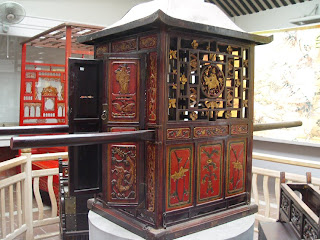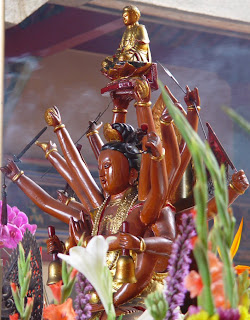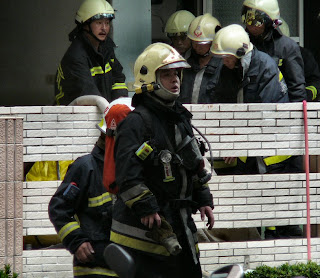Now, here is where

my journey to visit Wu Feng's place gets really strange. First, it would be of interest to say that when I had mentioned to the local teachers that I wanted to visit Wu Feng's memorial, they discouraged me, saying that it wasn't worth the hassle it would take to get there. If I took a bus it would take too long to get there and be difficult to get another bus back. They said 20 minutes tops and I would see everything there was to see and be bored. So..... I was totally delighted that there were in fact many things to see and the layout of the property was extensive. While I only posted a few of the photographs, I took many more and saw much more than what you see in the previous post. But that is just the beginning. It

wasn't until I was leaving the residence that the taxi driver mentioned we still needed to go visit the Wu Feng temple which was down the road. Ah, cool! More to see. I was totally unprepared for what I saw next. Perhaps the teachers had discouraged me from going because they didn't want me to know about this part of Taiwan. I was delighted. It put a whole new twist on my adventure on this island, Formosa. It started out rather deceptively, as from the front, the temple area looked quite small. An unimpressive temple and a few building looking quite similar to what I saw at the residence. There was an "entry fee" which surprised me. It was a rather high entry fee (for Taiwan) and I paid for my adm

ittance as well as that of the taxi driver because I wanted him to come along and translate for me. That was definitely a good move on my part as the place turned out to be huge and there was much to be translated or described in English. First, we entered a strange little room with Wasabi plants, charts about the growth of Wasabi, and even a few products for sale. Wasabi is grown in Alishan, as is oolong tea and many other products, so I wasn't particularly surprised to see a room of Wasabi here. As a matter of fact, I had been hoping to find some Wasabi coated peanuts and found them there. The building was not air conditioned and the temperature outside was most likely above 100 degrees F. Through a doorway was an incredible display of

artifacts from China, Japan and early Taiwan. I even saw a few things that looked suspiciously like early American products. The taxi driver described what the items were and how they were used, although there were a few things he didn't really know. It was delightful despite the fact that my clothes were beginning to be soaked in sweat and a steady stream ran from my scalp through the frizz of my hair. It was hard to tear myself away from those historic relics, but I knew if I stayed in that heat much longer I would suffer. It's hard to describe the feeling of standing there, inches away from a diorama created hunderds of years ago in China, ancient puppets, and handmade musical instruments played by many generations of Taiwanese, shoes worn by women with bound feet, Chinese bridal beds and Japanese "safety deposit boxes" slept on at nights to keep them safe. It was incredible.






 I'ts been a month now since I returned to America. On the day I left Chiayi, the clouds were dark and heavy over the city. The school had paid for me to take a taxi from my apartment to the airport in Taoyuan, a three hour drive. Clark, my regular English speaking taxi driver was waiting in front of my apartment complex at a quarter till three in the afternoon. Pei Ling stopped by earlier to collect some belongings I couldn't take back with me to the States. We walked to the taxi and hugged goodbye. I can't remember any time in my life when someone has treated me as well or been as supportive of me as Pei Ling has been during my stay in Taiwan. What an incredible person she is. I will long remember her standing there in front of my apartment gates, tears
I'ts been a month now since I returned to America. On the day I left Chiayi, the clouds were dark and heavy over the city. The school had paid for me to take a taxi from my apartment to the airport in Taoyuan, a three hour drive. Clark, my regular English speaking taxi driver was waiting in front of my apartment complex at a quarter till three in the afternoon. Pei Ling stopped by earlier to collect some belongings I couldn't take back with me to the States. We walked to the taxi and hugged goodbye. I can't remember any time in my life when someone has treated me as well or been as supportive of me as Pei Ling has been during my stay in Taiwan. What an incredible person she is. I will long remember her standing there in front of my apartment gates, tears  streaming down her face, as my taxi pulled away from the curb. Almost immediately, it began to rain and continued to rain throughout Chiayi County. Almost in a parallel to my thoughts and my mission for the day, the rain cleared by the time we were in Yulin County and clouds mingled with glimpses of clear sky. By the time we were near Taichung, we stopped for a break and a last supper. Clark bought me a traditional Taiwanese dinner of fish balls and chia. Now where in America could I find a taxi driver who would treat his passenger to dinner? He even gave me a gift of dried plums to take back on the long trip home. Taiwanese are such kind and generous people. I will long miss the hospitality and friendship. There are so many stories to tell about the adventure and the people. I wonder if I will ever tell them, or if perhaps, the photographs will have to tell the stories. Tonight I sit here in my empty house in Mansfield, Ohio, getting ready to begin a new adventure in Oregon in a few weeks. Why Oregon, you ask. Why not?
streaming down her face, as my taxi pulled away from the curb. Almost immediately, it began to rain and continued to rain throughout Chiayi County. Almost in a parallel to my thoughts and my mission for the day, the rain cleared by the time we were in Yulin County and clouds mingled with glimpses of clear sky. By the time we were near Taichung, we stopped for a break and a last supper. Clark bought me a traditional Taiwanese dinner of fish balls and chia. Now where in America could I find a taxi driver who would treat his passenger to dinner? He even gave me a gift of dried plums to take back on the long trip home. Taiwanese are such kind and generous people. I will long miss the hospitality and friendship. There are so many stories to tell about the adventure and the people. I wonder if I will ever tell them, or if perhaps, the photographs will have to tell the stories. Tonight I sit here in my empty house in Mansfield, Ohio, getting ready to begin a new adventure in Oregon in a few weeks. Why Oregon, you ask. Why not?

















































